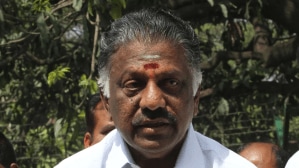Bow Bridge in Jalandhar: A strategic bypass route that provides ease of commute
Commonly known as the Laddewali Railway Over Bridge, it spans 450 meters in length, 9.52 meters in width, and was completed at a cost of approximately Rs 33 crore, including Rs 18.90 crore spent by the Punjab government.
 Laddewali Railway Over Bridge is the first bow bridge in Jalandhar and the second in Punjab. (Express Photo)
Laddewali Railway Over Bridge is the first bow bridge in Jalandhar and the second in Punjab. (Express Photo)The recently inaugurated ‘Bow Bridge’, the first of its kind in Jalandhar and the second in Punjab after Ludhiana, situated at Chaugitti bypass, has become the lifeline for over a dozen localities on the east and south sides of this bridge.
Commonly known as the Laddewali Railway Over Bridge, it spans 450 meters in length, 9.52 meters in width, and was completed at a cost of approximately Rs 33 crore, including Rs 18.90 crore spent by the Punjab government.
The bridge, a joint effort by the state government and the Indian Railways, has significantly eased daily commute for thousands of residents who have long endured poor road conditions across much of Jalandhar city.
According to officials from the Public Works Department, Building and Roads (PWD-B&R) in Jalandhar, both stakeholders shared the financial burden at a 60:40 ratio, with the state bearing 60% of the cost.
“Before the bridge, crossing the railway lines meant a long wait and detours,” said Jagdeep Singh, a resident who commutes daily from Nangal Shama to Guru Nanakpura.
Students and faculty at the Regional Centre of Guru Nanak Dev University, a hub for higher education, echo similar sentiments. “Previously, navigating congested routes or waiting at railway crossings was a challenge,” said Harpreet Singh, a law student at GNDU’s regional centre. “Now, I can reach the campus in Laddewali in minutes, saving valuable time every day. Earlier, I used to miss classes due to long waits at the railway crossing. And the wait was killing especially in the scorching summer heat,” he added.
The project, started in 2021 and completed on March 16, 2024, faced various challenges, including coordination with the railways for the elevated portion and laying essential sewerage lines. While the bridge is currently open to light vehicles, plans are underway to accommodate heavy vehicles after raising the height of nearby Bhakra Beas Management Board (BBMB)’s 220 KV lines by constructing a tower to increase the height from the current 5 meters to 12 meters. “The bridge has not only improved connectivity but has also enhanced the local economy,” said Rajesh Kumar, a shop owner near the bridge, adding, “More customers can reach my shop easily from across the railway lines, boosting sales and livelihoods.”
Moreover, the bridge offers a strategic bypass route for travelers heading towards Hoshiarpur from Jalandhar, bypassing congested areas such as Ramamandi. “This shortcut has significantly reduced travel time,” said Surabhi Gautam, a frequent commuter and school teacher. “I can now reach Nangal Shama from the city side in minutes, saving several kilometers on my journey.”
As Jalandhar embraces the convenience and efficiency brought by the Bow Bridge, residents are awaiting several other over bridges near Dakota, Guru Nanakpura, Karol Bagh, and near PAP on the national highway. These projects aim to streamline traffic flow and enhance connectivity across various parts of Jalandhar.
“With its transformative impact on daily life, the bridge exemplifies forward-thinking urban planning,” said a resident of Laddewali, highlighting the bridge’s role in enhancing property values in the area.
Gurmeet Singh, Executive Engineer (XEN) of PWD Provincial Division Jalandhar Cantt, elaborating on the significance of the overpass, said, “This bridge was long-awaited, and its construction was expedited. It now provides the shortest route from Jalandhar city to the Jalandhar-Hoshiarpur road, benefiting thousands of residents and the general public alike. Adequate parking facilities have also been provided under the bridge on both sides of the railway lines.”












